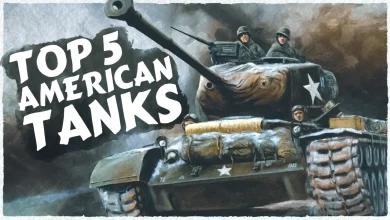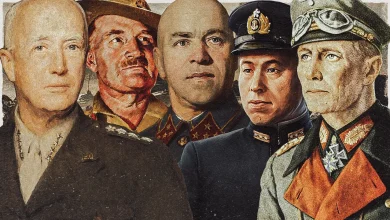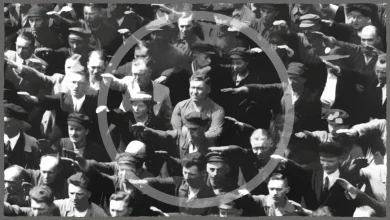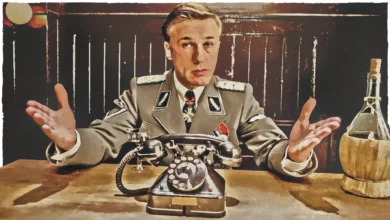British Commandos
After the 1940 evacuation from Dunkirk, the British look for new ways to combat the Germans until they can raise a huge army for an invasion force. PM Winston Churchill looks ‘to the Chiefs of Staff to propose measures for a ceaseless offensive against the whole German-occupied coastline leaving a trail of German corpses behind.’ They decide on commandos: ‘Specially trained troops of the hunter class who can develop a reign of terror down the enemy coast’.

Commandos are actually used by the British before Dunkirk. Looking into unconventional warfare for the Military Intelligence Research department, researchers were interested in a different type of soldier. By the spring of 1940, they have approval to recruit 10 new ‘guerrilla companies’ from other army units.

These are first deployed in Norway in April and then in Belgium during the Dunkirk evacuation.

They prove their value, blowing up 200,000 tons of fuel in Harfleur, after which Churchill asks for the ‘specifically trained hunter class’ on the 4th of June 1940.

This is the active beginning of the commandos.
The ‘Special Service Brigade’ is founded, commanded by J.C. Haydon. Because ‘Special Service’ has the initials SS, like the Nazi units, some prefer the term ‘commandos’, but both are used. The brigade quickly grows to 10 battalion-sized commando units, drawn from volunteers from the Norwegian guerrilla companies and from British Territorial Divisions.
Recruiters from Military Operations put out calls, looking for soldiers who are:

‘able to swim,
are immune from air and sea sickness,
able to drive motor vehicles
with courage, physical endurance,
active, marksmanship,
self-reliance and an aggressive spirit towards war
and must become experts in the military use of scouting
to stalk
to report everything taking place
to move across any type of country, day or night, silently and unseen
and to live off the land for considerable periods.’
Shortly after their establishment, they set out on their first missions, with varied success.

Operation Ambassador, a raid on German barracks on Guernsey in July 1940, sees some units land on the wrong island, and those who do make it to the barracks find that it has been abandoned.
A more successful raid is Operation Claymore in March 1941, in which commandos no. 3 and 4 destroy 11 ships, factories, and a lot of resources on the Norwegian Lofoten Islands.

They also manage to capture around 100 German POWs, and enemy codebooks and encryption equipment.
Other 1941 operations are those of LAYFORCE. This is under the command of Lieutenant Colonel Laycock, hence the name Layforce, Commandos no. 7, 8, and 11 join Middle East Commandos 50 and 52 to support operations there, totaling roughly 2000 men.

They engage in action in North Africa in a raid on Italian positions in Bardia, with mixed results.

Soon, though, they find themselves fighting as infantry in the Battle of Crete – much to Churchill’s dislike because that is not their intended use. Lacking equipment and training for a long defensive campaign, they lose most of their numbers.
The survivors of Layforce will within months be part of the foundations of the Special Air Service- SAS.


It isn’t until 1942 that the commando branch truly comes into its own. First of all, it is only now that the commandos get their own dedicated training grounds.
Achnacarry in the Scottish Highlands is dubbed the ‘Commando Basic Training Centre’.

Before March 1942, new commandos are trained somewhat ad-hoc by their commanding officers. This results in wide-ranging skill-sets and varying levels of quality. The new school is run by Lt. Colonel Charles Vaughan, a World War One veteran who has designed a physically and mentally demanding course to drill the volunteers into the best of the best.

The drills build on the doctrine of Brigadier Haydon, who led the commandos for the first two years of their existence but has since been replaced by Lord Mountbatten. Emphasis still lies on stealthy raids, but recruits are expected to be superb fighters and great soldiers. One instructor recalls how Vaughan, ‘accepted nothing but the best, whether it be fitness, weapon training and musketry, fieldcraft and tactics, drill and turnout, or even in the more apparently mundane matters of administration which included feeding and hygiene. Together all these factors made the ‘whole’ – and the self-disciplined and reliant Commando soldier, ‘fit to fight and fighting fit’, with high morale, willing and capable of tackling any military task, under any circumstances and against any odds’.
The recruits are trained in unarmed combat, bayonet fighting, navigational skills, rock-climbing and living off the land. Because of the marine nature of their deployment, they train the use of landing craft, canoes, and other boat types on nearby loch Lochy. Additional attention is given to swimming, which might seem trivial until you realize that many missions end with the soldiers having to swim back to their naval escort boats, often in cold, rough seas and at night.

Some commandos receive additional training in arctic combat, for which a second training camp at Braemar in Scotland is opened late in 1942.

Famous Mountaineer Frank Smythe designed a course in which recruits learn how to survive in a sub-zero climate, complete with lessons in skiing, mountaineering, and elevated combat. Most training is conducted with live ammunition and in full battle-gear, including obstacle courses and long night-time marches. The course ends with a hyper-realistic simulated beach landing on the coast of Scotland.
An interesting footnote here: until the Achnacarry school opened, the commandos all wore their own regimental insignia and caps.

With the argument that this doesn’t do team spirit any good, a local Scot is asked to design a new uniform beret – in Lovat green. From then on, green berets will become a visual hallmark of the elite units.
But at the core of what makes a commando are his weapons and tactics. ‘Hit and run’, ‘smash and grab’, ‘butcher and bolt’. Just some of the simple ways to describe what a commando does. Their main methods revolve around making a quick, stealthy entrance without alarming the enemy. Their tasks most often are to destroy something, gather intelligence, take prisoners, or a combination of the three.

They are then to leave the way they came, often via sea-borne extraction.

This usually doesn’t all take longer than 24 hours. Their equipment reflects that, with emphasis on clubs and knives, like the specifically developed Fairbairn-Sykes fighting knife,

or Lee-Enfleid rifles, often with an added sniper scope.

Grenades and weapons with high stopping power and a high firing rate like the Thompson sub-machines gun with a 20-round box magazine,

and light machine guns like the .303 Bren are used to sow as much chaos as possible when it does come to a gunfight.

The commando formations are not really trained in using any defensive tactics, though. They lack anything bigger than light personal arms, so they really can’t engage with an organized enemy in a defensive position. They do some serious damage, though. Throughout 1942 and 1943, they carry out numerous hit-and-run operations all around the globe.

They are active in Europe, East-Asia, North-Africa, and the Arctic. The commandos themselves are increasingly diverse as well. After the initial imprisonment of enemy aliens, German and Austrian Jews now serve in the Inter-Allied Commando no. 10, together with volunteers from other occupied territories. Their raids can be pretty spectacular.

In January 1942, No. 62 Commando engages in Operation Postmaster. They seize three Italian and German ships, including a tanker, on the neutral Spanish port of Santa Isabel on Fernando Po island.
In March that year, the ‘greatest operation of all time’, Operation Chariot, sees the French coastal town of St. Nazaire raided by No. 2 Commando. It’s a daring episode in which the destroyer HMS Campbeltown, packed with explosives, rams through the gates of the docks of St Nazaire.

In the chaos, the commandos go out to destroy as many facilities as they can, like the pumping station and another dry dock gate. Hours after departure, the timed explosives go off, taking out the drydock for the remainder of the war, effectively barring the Germans from housing their largest capital ships there, as it is the only port on that coast that could do so before that. Such a result doesn’t come without losses, though, as a total of 169 commandos and navy servicemen are killed, and many more than that are taken prisoner.

But soon, the role of the commando starts to shift. From 1943 on, coastal raids will become less important. See, when the allies start taking the initiative and preparing larger-scale landings, the idea of coastal raiding will become less and less relevant for the Allied war effort. Instead, commando training will increasingly include defensive infantry tactics. Their equipment changes accordingly.
They will receive more firepower like a larger number of Bren guns, 2 and 3-inch mortars, and anti-armor weapons like the Projector Infantry Anti-Tank (PIAT) guns. They will also have motorized vehicles like jeeps, motorcycles, and trucks to be more mobile.

However, the emphasis of their combat will always remain on bold and aggressive tactics, stealth, hand-to-hand combat, and ambushes. Their methods very much inspire other army units, including the United States Army Rangers, many of whom also receive training at Achnacarry.
The word ‘Commando’ will live on as a synonym for an elite soldier, a name still carried proudly by such units worldwide.



